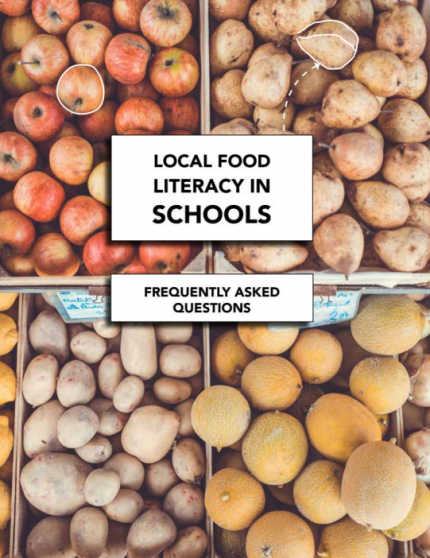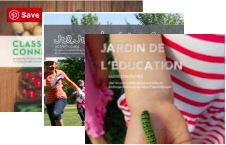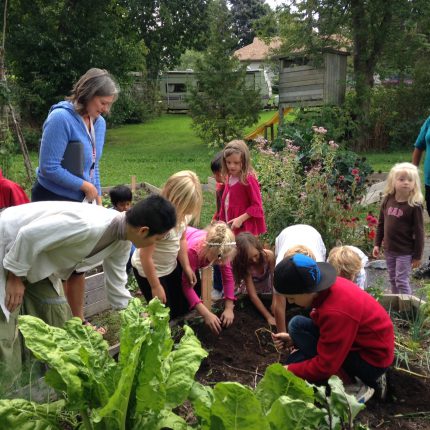A Q&A Lesson in Local Food Literacy: How do I get my students excited and engaged?
Posted: February 6, 2018
Categories: Edible Education Network / Good Food Ideas for Kids / GoodFoodBites / News from Sustain Members / News from Sustain Ontario / Schools
 Welcome to the first of 10 blog posts in a series on bringing Local Food Literacy into Ontario schools!
Welcome to the first of 10 blog posts in a series on bringing Local Food Literacy into Ontario schools!
You might remember our Local Food Literacy in Schools FAQ Guide, developed by Sustain Ontario, Ecosource, FoodShare and Roots to Harvest. Due to great interest in this resource (and in bringing local food education into our schools in general), we’ve decided to break down each question from the guide into a blog post full of information, ideas, answers and resources to further share! Join the conversation here on Twitter. Our first blog post in the series will explore…
How do I get my students excited and engaged in local food literacy?
Food is inherently exciting! Below are some ideas to engage your students.
Build on different access points:
Link gardening with cooking – Cooking helps students care more about gardening and gardening helps students care more about cooking. Students are more likely to eat food if they’ve grown it themselves. They also care deeply about a plant if they’ve grown it, can eat it, know what it tastes like, and know how to cook it. Bring cooking into the school in different ways such as in class, with a club, in an after-school program and/or in an employment program.
For instance, a Guidance & Co-operative Education Teacher at a Toronto Elementary School recently shared with us, “Our lettuce is huge! We have so much lettuce that we’ve done a salad making competition, harvested lettuce for another class to eat, and the girls take leaves of lettuce to go on many days just because they want a snack!”
Take a look at school lunch – there’s food in school every day.
Student Nutrition Program links – make food exciting. Visit http://foodshare.net/program/blender/ for instructions on how to build a bike blender with students.
Curriculum links – think outside the box.
Business classes – look at selling food. Language classes – do literacy activities. Arts classes – do signage & photography. Geography classes – map the garden or the local community in terms of food access.
Field trips – visit food co-ops, farms, markets, and other locations.
Play spaces – Growing food can happen outside of conventional gardens and can enhance playground environments. Plant perennial herbs like thyme as a groundcover to provide a sensory play experience or build natural shade structures with climbing beans to create inviting spaces for children to explore.
Make it relevant – Ensure that the food reflects students’ cultures and what they eat at home. Include different ways for students to engage (e.g. building irrigation systems, painting a mural, starting a seedling).
Use the “ooh and ahh” factor – Think about how to make local food literacy exciting. Bees (and a beekeeper), for instance, can have that kind of effect!
Recognize that youth are food experts – They’ve eaten a lot of food! Acknowledge what they know and use that in your programming. E.g. students can write curriculum for an after school or growing program. Or have older students mentor younger students in a cooking project.
Give students choice about what they’re growing, cooking, and eating.
Celebrate student leadership – Have a “Food Champ” or “Garden” Award at a graduation or year-end assembly.
Create food system volunteer roles for students who need volunteer hours. E.g. managing a compost system, salad bar ambassador (to encourage students to eat fresh salad), prepping for snack program.
Celebrate your success – Share your school food stories on school social media accounts, school newsletters, at school-wide events. Invite your local school board trustees and city councillors out to a garden launch or harvest party.
Check out these teaching resources
From Ecosource:
Classroom Connects (Gr. 9-12)
Re-rooted in Play (K-8)
Jardin de L’Éducation (Bilingual)
http://ecosource.ca/about-us/publications/
These resources include lesson plans and activities for students to learn about and explore our local food system as well as the complexities of our food choices.
From FoodShare Toronto:
Field to Table Schools Workshops
http://foodshare.net/program/educator/
FoodShare’s website provides Ontario curriculum-linked lesson plans (K-12) about cooking and tasting, growing, nutrition, media and many other aspects of our local food system.
For more information and guidance on providing local food education at your school, be sure to check out recordings from our Local Food Literacy in Schools Webinar series from last year.
Stay tuned for the next blog post in this series, and in the meantime, connect with us on Twitter and share how you get students excited about local food literacy!

2 responses to “A Q&A Lesson in Local Food Literacy: How do I get my students excited and engaged?”
Leave a Reply
You must be logged in to post a comment.


[…] hope you enjoyed our first blog post in a series on bringing Local Food Literacy into Ontario schools. This blog series is intended to […]
[…] we looked at getting students engaged, then we highlighted resources and ideas for school gardens — now, for the third blog post in […]